NVIDIA GeForce GTX 770 Review: The $400 Fight
by Ryan Smith on May 30, 2013 9:00 AM ESTAlthough GTX 770 is already a very high clocked part for GK104, we still wanted to put it through its paces when it comes to overclocking. Of particular interest here is actually memory overclocking, as this is the first video card shipping with 7GHz GDDR5 standard. This will let us poke at things to see just how far both the RAM itself and NVIDIA’s memory controller can go.
Meanwhile the switch to GPU Boost 2.0 for GTX 770 is going to change the overclocking process somewhat compared to GTX 680 and GTX 670. Overvolting introduces marginally higher voltages and boost bins to play with, while on the other hand the removal of power targets in favor of TDP means that we only get 106% – an extra 14W – to play with in TDP limited scenarios. Thankfully as we’ve seen we’re generally not TDP limited on GTX 770 at stock, which means our effective headroom should be greater than that.
| GeForce GTX 770 Overclocking | ||||
| Stock | Overclocked | |||
| Core Clock | 1046MHz | 1146MHz | ||
| Boost Clock | 1085MHz | 1185MHz | ||
| Max Boost Clock | 1136MHz | 1241MHz | ||
| Memory Clock | 7GHz | 8GHz | ||
| Max Voltage | 1.2 | 1.212v | ||
We’re actually a bit surprised we were able to get another 100MHz out of the GPU itself. Even without the extra overvoltage boost bin, we’re still pushing 1200MHz+ on 1.2v, which is doing rather well for GK104. Of course this is only a 9% increase in the GPU clockspeed, which is going to pale in comparison to parts like GTX 670 and GTX 780, each of which can do 20%+ due to their lower clockspeeds. So there’s some overclocking headroom in GTX 770, but as to be expected it's not a lot.
More interesting however is the memory overclock. We’ve been able to put another 1GHz on 6GHz GTX 680 cards in the past, and with the 7GHz base GTX 770 we’ve been able to pull off a similar overclock, pushing our GTX 770 to an 8GHz memory clock. The fact that NVIDIA’s memory controller can pull this off is nothing short of impressive; we had expected there to be some headroom, but another 14% is beyond our expectations. At this clockspeed the GTX 770 has a full 256GB/sec of memory bandwidth, 33% more than both a stock GTX 680 and the 384-bit GTX 580. Of course we’ll see if GTX 770 can put that bandwidth to good use.
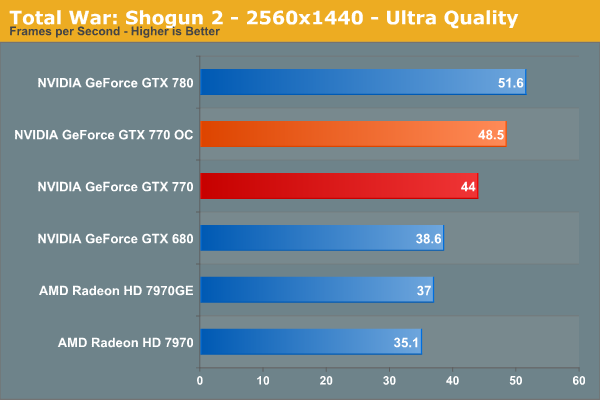
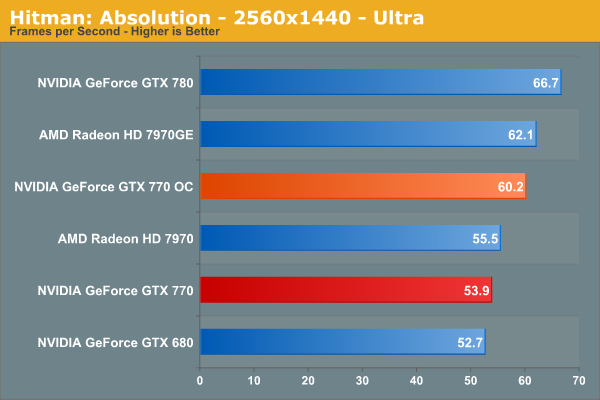
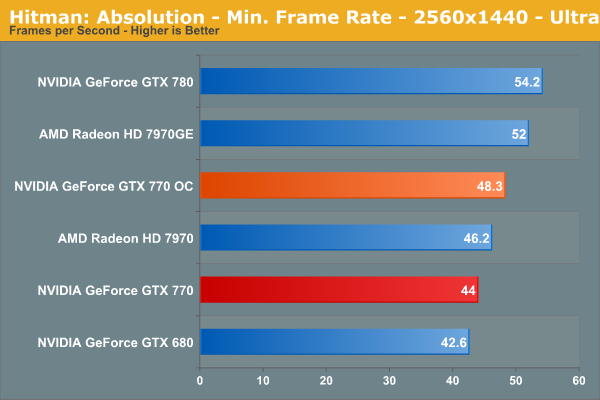
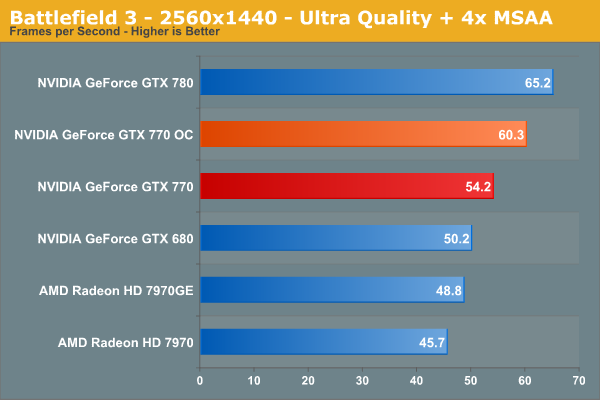
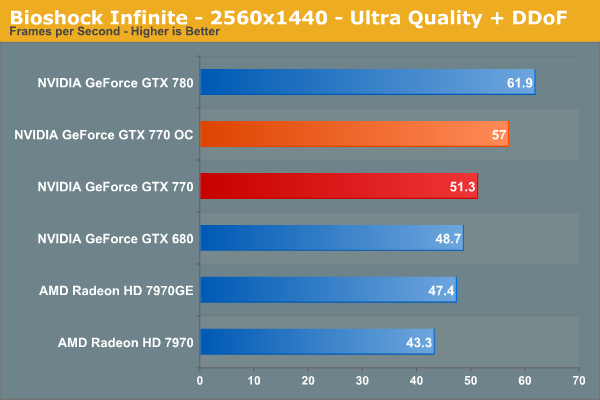
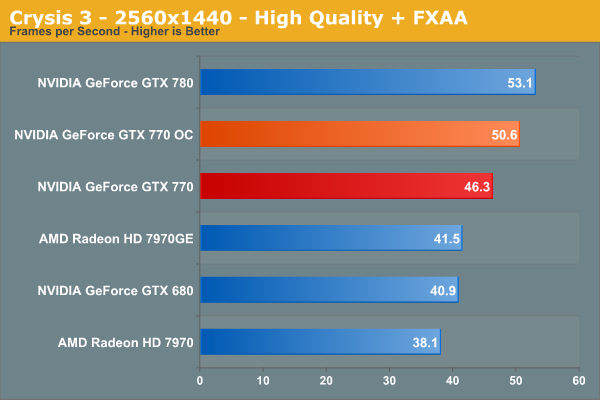
The end result of our overclocking efforts nets a very consistent 9%-12% increase in performance across our games. 9% is the upper bound for improvements due to GPU overclocking, so anything past that means we’re also benefitting from the extra memory bandwidth. We aren’t picking up a ton of performance from memory bandwidth as far as we can tell, but it does pay off and is worth pursuing, even with the GTX 770’s base memory clock of 7GHz.
Overall overclocking can help close the gap between the GTX 770 and 7970GE in some games, and extend it in others. But 10% won’t completely close the gap on the GTX 780; at best it can halve it. GTX 780’s stock performance is simply not attainable without the much more powerful GK110 GPU.
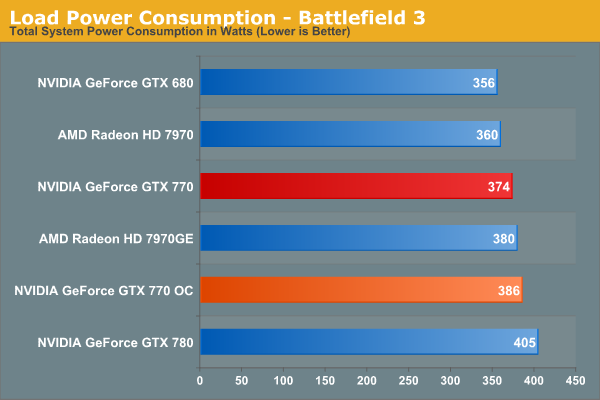
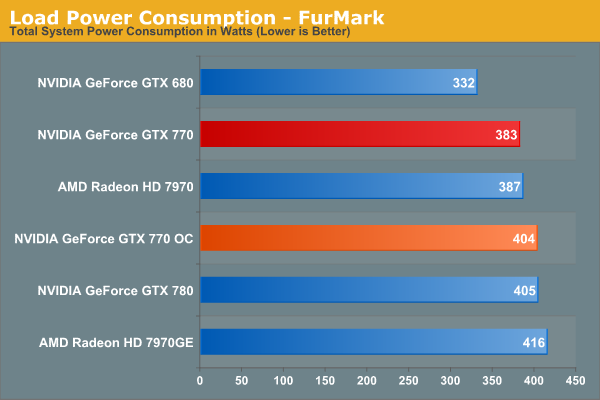
Moving on to power consumption, we can see that the 106% TDP limit keeps power usage from jumping up by too much. In Battlefield 3 this is a further 12W at the wall, and 21W at the wall with FurMark. In games this means our power usage at the wall is still below GTX 780, though we’ve equaled it under FurMark.
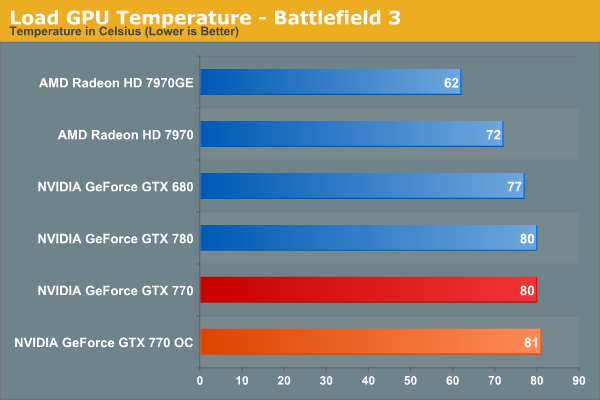
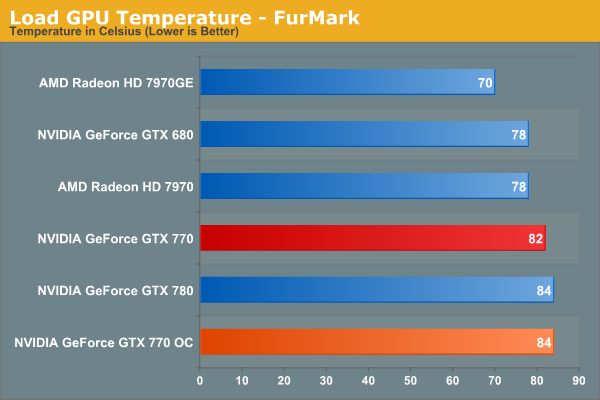
The fan curve for GTX 770 appears to be identical to that of GTX 780. Which is to say the fan significantly ramps up around 84C, keeping temperatures in the low-to-mid 80s even though GPU Boost 2.0 is allowed to go up to 95C.


Finally for fan noise, we see a small increase under Battlefield 3, and no change under FurMark. 1.5dB louder under Battlefield 3 puts noise levels on par with the GTX 780, sacrificing some of GTX 770’s abnormally quiet acoustics, but still keeping noise below the 50dB level. Or to put this another way, the performance gains for overclocking aren’t particularly high, but then again neither is the cost of overclocking in terms of noise.










117 Comments
View All Comments
ninjaquick - Thursday, May 30, 2013 - link
Delta Percentages: The 7990 just needs to be removed, it skews the whole chart way too much.Brainling - Thursday, May 30, 2013 - link
It's a nice card, but not nice enough for me to upgrade my 670. If it had been a slightly more paired down GK110, I would have considered it...but the performance gains are just not enough to justify replacing my 670 (which still has little trouble with most games).I'll spend my computing dollar on going from Sandy Bridge -> Haswell instead, and wait for the eventual 800 series sometime next year (which should be a new micro architecture).
The0ne - Thursday, May 30, 2013 - link
"... the rest of the year will be a battle of prices and bundles."Can't wait.
Runadumb - Thursday, May 30, 2013 - link
Firstly Thank you for the detailed review.Right, I could pull the trigger on two of these (when they come out with 4GB versions) as they are 85%+ above my current 2x570GTX's. Thanks for having 570's in the results by the way.
My BIG question is: Is the proper next-gen cards still due early next year or is this all we've got for the next 18 months? The rumour mill is fine here.
As I run 3 displays and a 6000x1080p resolution I literally can never have too much performance. So if waiting until next year meant I get a better upgrade I'm happy to do it. This system can just about keep me going right now.
I may abandon the 3 screen setup for a consumer version Oculus Rift but how long away is that? I want to hedge my bets.
jwcalla - Thursday, May 30, 2013 - link
I think Maxwell is going to be more like mid-2014. It seems aggressive though... a new architecture, a shrink to 20nm and they're shoe-horning a 64-bit ARM chip in there. Lots of opportunities for delays IMO. But it might be a wise idea to wait... NVIDIA is promising (read: take with a grain of salt) 3x "GFLOPS per watt" over Kepler, and about 7-8x over Fermi. It's hard to predict how that will scale into performance though.Ryan Smith - Thursday, May 30, 2013 - link
It would be historically accurate to state that NVIDIA typically releases new architectures on new nodes, and that both Maxwell and TSMC 20nm are scheduled for 2014. When in 2014 is currently something only NVIDIA could tell you.But I would say this: consider this the half-time show. This is the mid-generation refresh, so we're roughly half-way between the launch of Kepler and Maxwell.
araczynski - Thursday, May 30, 2013 - link
Hopefully by the time I replace my aging E8500/6970 system (which still plays everything I care about pretty well at 1080p) with a haswell, this thing will have a 4GB option so i can make another long lasting rig.xdesire - Thursday, May 30, 2013 - link
Ok i see that this is an overclocked/tweaked GTX 680 but what in the hell is that TDP?!HEADHUNTERZ! - Thursday, May 30, 2013 - link
Soooo...where does the GTX 670 FTW compare to the GTX 770!? Theyre both the same price! So which one would be a better decision to make?JPForums - Thursday, May 30, 2013 - link
They won't be priced the same for long. Unfortunately, I just can't see a GTX670FTW beating a GTX770 (especially with a factory overclock). I wonder if there is enough overclocking headroom for a GTX770FTW.